Introduction
Histopathology is the microscopic examination of tissues to aid in the analysis and detection of disease as it manifests itself. This microscopic examination helps to pinpoint tissue anomalies as they occur. Histopathology is important in the early detection of some conditions, for example, cancer, and this is important because it increases survival. The process is carried out by pathologists, who place specimens of tissue extracts on glass slides for observation. The purpose of this paper is to discuss the histopathological examination of the breast tissue aimed at denoting the differences between normal and diseased tissue with reference to fibroadenoma, lobular hyperplasia and scirrhous carcinoma.
Aims of the Experiment
This experiment aimed at examining and drawing sections of normal and disease tissues. In addition, it entailed giving a description of the characteristics of the diseased tissue in relation to the morphological structures seen under the microscope. Later on, a thorough analysis to denote the differences between abnormal and normal breast tissue was imperative. This differentiation of morphological changes enables pathologists to determine the status of a tissue after biopsy.
Methods
This histological experiment followed a series of steps. First, tissues were harvested through surgery, biopsy or autopsy and stabilized to avoid degradation. After fixation through chemical fixation and mounting, Haematoxylin and Eosin were used to stain the tissue sections to enable ease in observation under a microscope. Each slide was examined in three stages: using the naked eye, under low power (x40 magnification) and under high power (x100 to x400 magnification).
Results and Discussion
Normal Breast Tissue
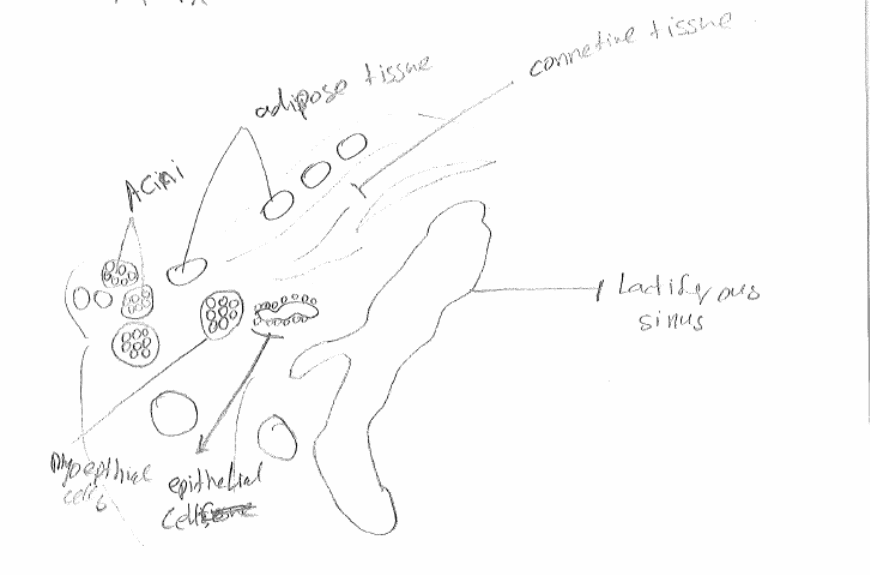
The figure 1 above is a cross-section histological view of the human breast tissue under low magnification. The Acini, epithelial cells, myoepithelial cells, adipose tissue, lactiferous sinus and some mass of connective tissue are evident. The epithelial and myoepithelial cells line the lobules and ducts. The epithelial cells are columnar in shape and act as the inner secretory lining. The myoepithelial cells, on the other hand, act as the outer lining beneath the epithelial cells.
Lobules make up the epithelial section of the breast tissue, and it is here that milk is made. The lobules connect to ducts, which connect to the nipple through lactiferous sinuses and lactiferous ducts. The lobules emerge from lobes, and there are 15 to 20 lobes in each breast.
The connective tissue is fibrous in structure, as can be seen in figure 1 above, and they separate the lobes. Each lobule is connected to an intralobular duct, which empties into an interlobular duct before emptying into one of the lactiferous duct. The Acini are components of the lobules, and they act as the terminal glands of the lobules. The acini, also called the alveoli are hollow sacs that are responsible for the production of milk. The adipose tissue prevails in the interlobular area and appears as scattered cells.
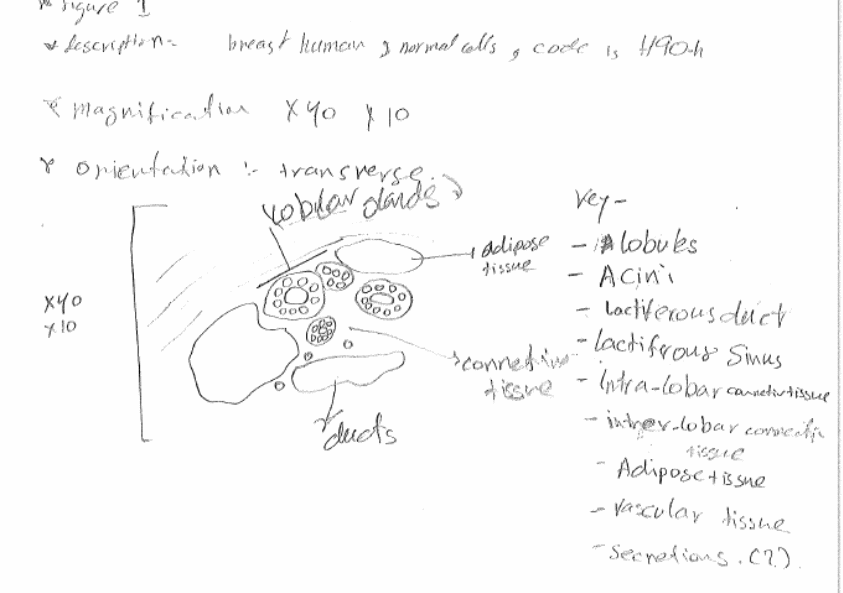
Based on the examination from this experiment, it is evident that a normal breast tissue has a large number of connective tissue in comparison to the lobular tissue in a ratio 3:1 respectively. Under higher magnification, more structures are evident.
Disease Breast Tissue-Lobular hyperplasia
Abnormal proliferation of cells that line the lobes in the breast tissue is called lobular hyperplasia or lobular neoplasia. Lobular hyperplasia includes either atypical lobular hyperplasia or lobular carcinoma. Lobular carcinoma affects the breast lobules only without invading the surrounding tissue. Atypical hyperplasia is characterized by a distorted pattern. Atypical lobular hyperplasia is the abnormal growth of discohesive cells that are less than 50% away from the acini in the lobule.
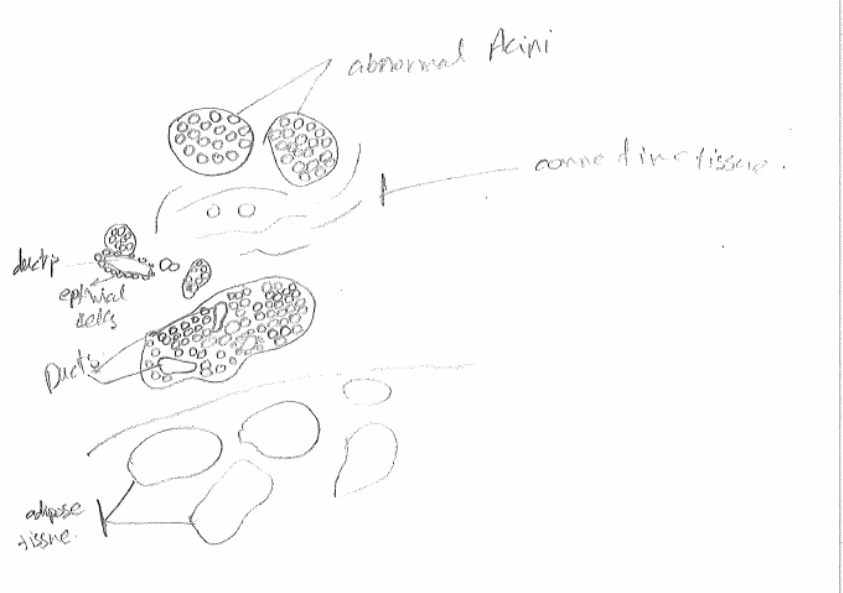
In comparison to a normal breast tissue, the diagram below under high magnification indicates a high number of lobules and its lining cells (the epithelial and myoepithelial cells). As indicated in the definition of this condition, lobular hyperplasia affects the lobules and the epithelial cells; hence the reason for the high numbers of these two in the diseased lobular hyperplasia tissue. Under high magnification, the ducts are also affected and instead of their normal hollow shape, they are proliferated with the abnormal epithelial cells.
A peculiar observation is the subsequent increase of connective tissue with the increase in the number of lobules. As a result, in comparison to a normal breast tissue, the diseased lobular hyperplasia human breast tissue is densely populated with lobules, epithelial and myoepithelial cells.
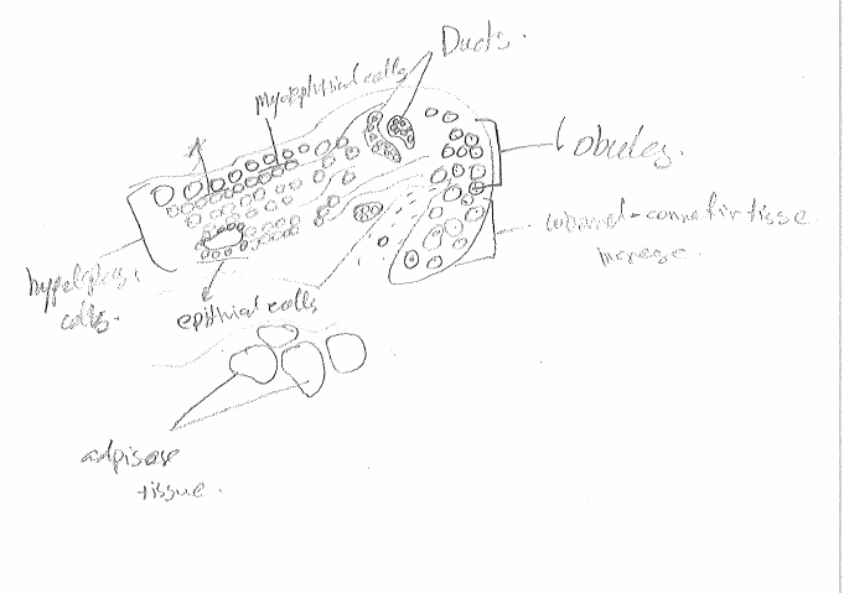
Lobular hyperplasia does not cause an easily felt lump; hence, biopsy is the method through which diagnosis can be made. Diagnosis is dependent on the extensiveness of the area affected and the degree of change of the affected cells. Diagnosis is by chance through calcifications on a mammogram. A mammogram can also be used to check for changes caused by the hyperplasia. Lobular hyperplasia is not cancerous, and it is not associated with any pain.
This malignancy is common among women above the age of 35 years. Despite the fact that most women who are diagnosed with either atypical lobular hyperplasia or lobular carcinoma in situ do not get breast cancer in future, lobular neoplasia is deemed a risk factor of breast cancer. There is no specific treatment for lobular neoplasia; however, discussing treatment with one’s doctor is paramount. An excision biopsy may be performed to reassure the patient. Tomaxifen is reported to aid in the risk reduction of developing breast cancer. Lobular hyperplasia is harmless; hence, recovery is quick and survival is guaranteed.
Diseased Fibroadenoma Breast Tissue
Fibroadenoma is a common tumor (benign) among women, but with a peak incidence in the younger generation (women of childbearing age). This tumor is painless, firm, grows slowly, mobile and appears as a solitary mass with clearly defined nodules that measure up to 3cm, but these can be as large as 20cm. Despite the fact that fibroadenoma is benign (non-cancerous), it is associated with risk for subsequent breast cancer greatly inclined to “complex changes within the benign cyst, family history of breast cancer and proliferation of fibroadenoma in the surrounding parenchyma.” Fibroadenoma comprises of two components: the epithelial and the stromal components.
Under low magnification indicated in figure 5 below, there is a great difference between the diseased breast tissue due to fibroadenoma and the normal breast. A look at the figure 5 below indicated circumscribed lobular tissue and evident ductal spaces separated by a large volume of stroma. This is a form of pericanalicular fibroadenoma because the ducts remain as round or oval spaces. Under low magnification, the connective tissue is not visible, and the lobular tissue next to the adipose tissue is smaller in size in comparison to a normal breast, in which all the lobules are uniform.
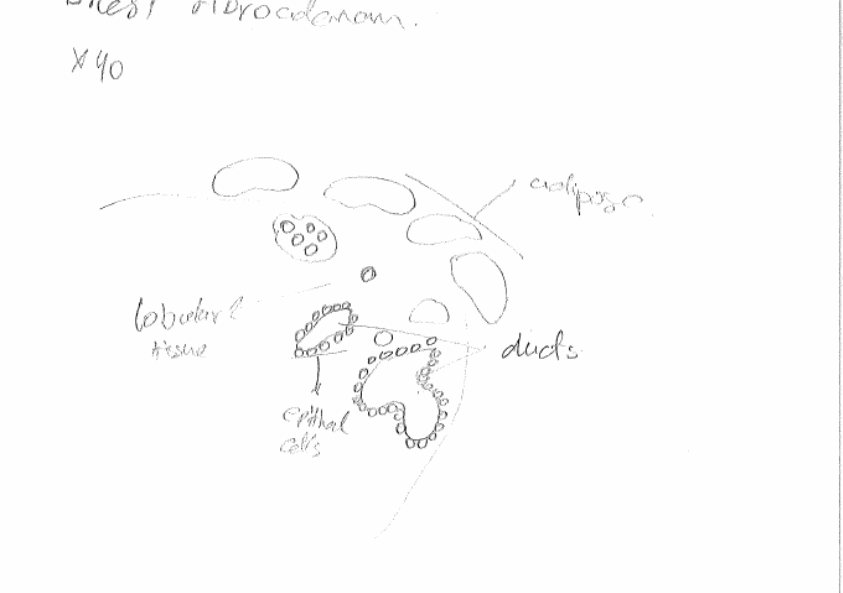
Under high magnification (figure 6), the shape of the acini at the center of the tissue is tubular as the stroma cells proliferate and force the epithelial cells to narrow down into thin slits. According to the two diagrams, the fibroadenoma is gradually enlarging leading to the change in shape of the lobules. As indicated by the diagram, fibroadenoma mainly appears in the upper outer region of the breast.
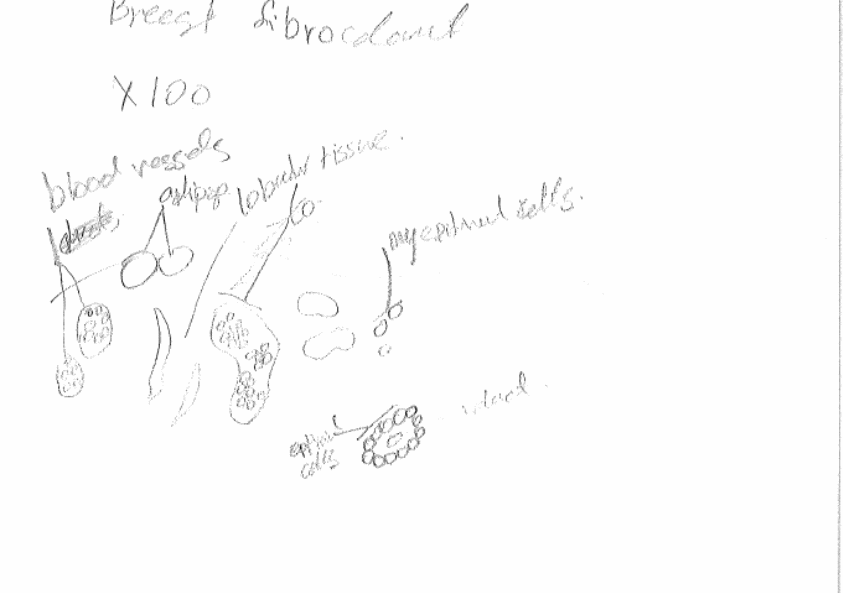
There are no evident signs and symptoms associated to fibroadenoma because it is a harmless tumor that does not trigger any inflammatory response. However, during a medical or self-examination, it can be detected as a mobile firm and solitary mass. Small fibroadenomas that cannot be felt can be discovered through screening. There are various treatment approaches that are proposed for fibroadenoma.
Excision has been indicated as an effective approach because there is no recurrence, in most. In other cases, it is presumed that the tumor will clear off with time; hence, monitoring (conservative management), only, for a period of six months is imperative as the tumor is expected to shrink. However, advocate for a thorough examination while taking into consideration various parameters such as family history, information on proliferative changes or patient’s age.
The prognosis of fibroadenoma is unpredictable because it can take more than one course. Naturally, a fibroadenoma is 1 to 3 cm in size and can remain this way for around five years. After this time, it can either remain the same for a long time or begin to shrink gradually. On a different note, the fibroadenoma can become a giant fibroadenoma if it is more than 5cm in size. This is when excision is highly recommended. The excision is a minor surgical procedure that takes an hour, at most, and the patient is allowed to go home the same day.
Diseased Scirrhous Carcinoma Breast Tissue
Scirrhous carcinoma also called invasive ductal cancer is a type of breast cancer. Scirrhous carcinoma is defined as hard, fibrous and invasive malignant cells that can occur in solitary, clusters or strands within the connective tissue. These carcinomas are salient among the elderly women. The American Cancer Society indicates that more than 60% of women diagnosed with invasive ductal carcinoma are at least 55 years old. The prevalence of lobular scirrhous is low due to rare diagnosis reports. On the other hand, invasive ductal types are the most prevalent and affect around 80% of women with breast cancer. Scirrhous carcinoma is called invasive because it spread to the surrounding tissues in the breast. It is ductal because it begins in the milk ducts.
In comparison to the normal breast under low magnification (figure 7) below indicates that the breast tissue is predominated by invasive ductal carcinoma. The important structures defining the breast tissue are not present, presumably because the tumor has overridden them. As earlier noted, this carcinoma begins in the ducts, and as it spread to the sub-divisions of the duct, it takes over the entire duct and lobes; hence, their disappearance. The invasive carcinoma cells appear as an irregular mass of cells that trigger desmoplastic reaction resulting in stroma proliferation.
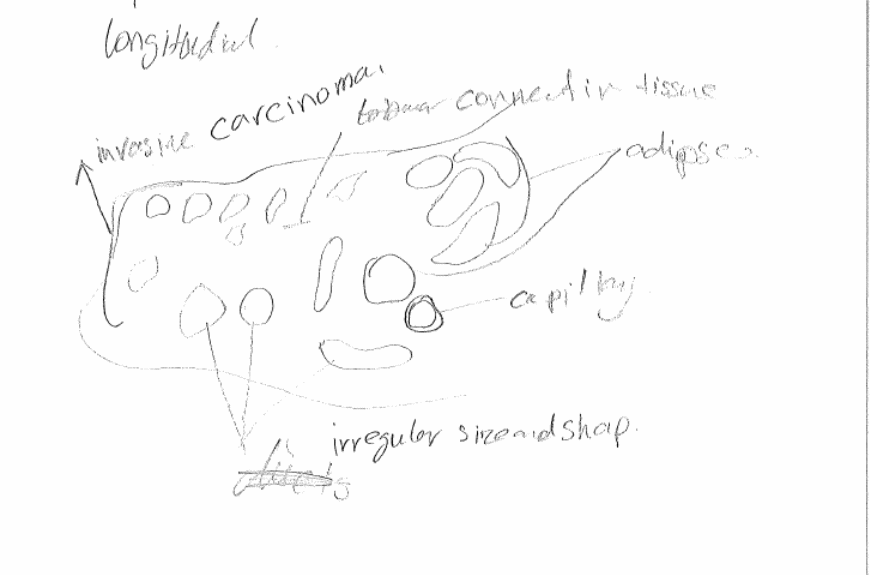
A higher magnification of up to x100 (figure 8) highlights the mitoses of the tumor because they are the main occurring masses within the sparse connective tissue. The diagram does not resemble the breast tissue at all apart from the adipose tissue, which seem to be unaltered by the entire invasion of the carcinoma.
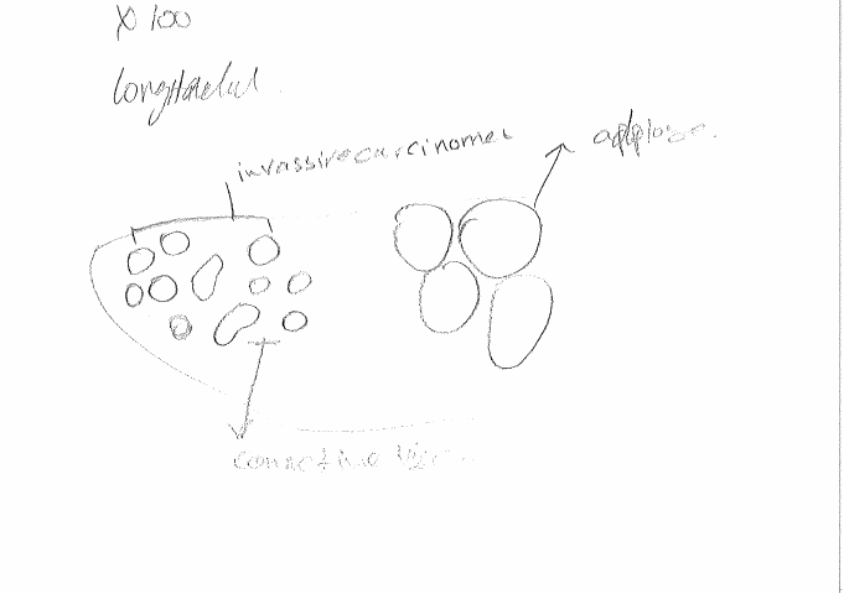
Initially, invasive ductal carcinoma does not present any symptoms, but abnormality is evident upon screening, and this leads to further subsequent testing. A lump is the first and main sign of scirrhous carcinoma, and this can be noticed through self- or medical-examination. However, other signs stated at breastcancer.org include “breast pain, nipple discharge, redness, scaliness or thickening of the nipple or breast, swelling of part or the whole breast, skin irritation and the presence of a lump” are evident. Treatment for scirrhous carcinoma is either local or systemic. Local treatments include surgery and radiotherapy, which are used to treat the invasive carcinoma itself and any other tissue that may be affected, for example, the lymph nodes.
Surgery is the first option if the tumor is not large. However, if the converse if the converse is the case, chemotherapy or hormonal therapy is first employed so the cancer can regress. Surgical procedures are varied and the procedure chosen depends on how far the cancer has spread. Radiotherapy is used to prevent recurrence because it is often recommended after surgery. Systemic treatments entail the use of medication that has an effect on the whole body, and they help to reduce recurrence. Treatments used include “chemotherapy, hormonal therapy and targeted therapies”. Prognosis of scirrhous carcinoma varies with reference to the time of diagnosis and stage of the carcinoma. Early diagnosis means better prognosis and survival while the converse is the case.
References
Ackland, L & Loke, S 2013, SLE346 Molecular Basis of Disease, Deakin University Press, Geelong.
American Cancer Society 2014, Non-Cancerous Breast Conditions. Web.
Atlas of Pathology (3rd ed) 2004. Web.
Bewtra, C 2009, ‘Fibroadenoma in women in Ghana’, The Pan African Medical Journal, 21 July, viewed 20 September 2014, via PubMed.
Breast 2006. Web.
Cancer Research UK 2014, Statistics and outlook for breast cancer. Web.
Chinyama, CN 2011, ‘Normal Morphology, Physiological Changes, and Benign Breast Disease’, in FM Dirbas CH Scott-Conner (eds), Breast Surgical Techniques and Interdisciplinary Management, Springer Science, New York, pp. 65-81.
Greenberg, R, Skornick, Y, & Kaplan, O 1998, ‘Management of Breast Fibroadenoma’, Journal of General Internal Medicine, vol. 13, no. 9, pp. 640-645.
IDC-Invasive Ductal Carcinoma 2013. Web.
Kuijper, A, Mommers, EC, van der Wall, E, & van Diest P 2001, ‘Histopathology of Fibroadenoma of the Breast’, Am J Clin Pathol, vol. 115, pp. 736-742.
National Cancer Institute 2014, Lobular Carcinoma In Situ. Web.
Thomas, P 2011, Breast Cancer and its Precursor Lesion: Making sense and making it early, Springer Science, New York.